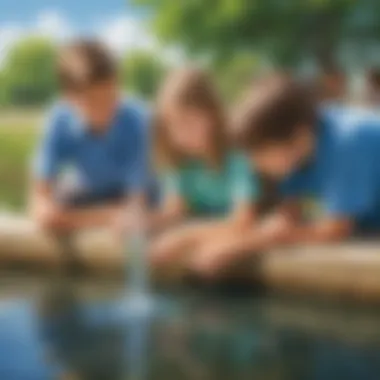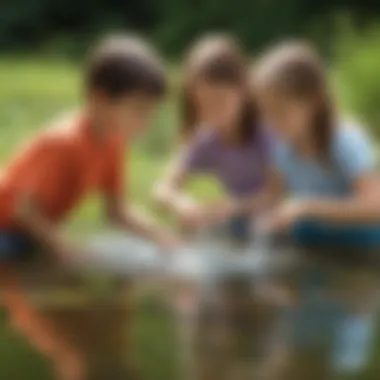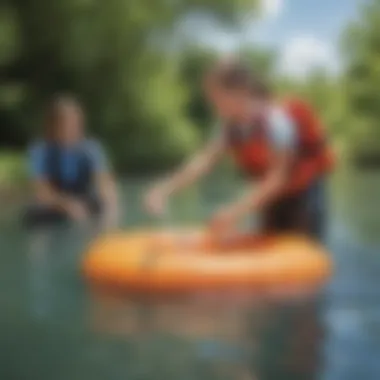Engaging Outdoor Water Science Experiments for Inquisitive Kids


Science Fun Facts
Water is essential for life and covers about 71% of the Earth's surface, playing a vital role in various ecosystems and the water cycle. Did you know that water is the only substance on Earth that naturally exists in three states - liquid, solid (ice), and gas (water vapor)? Understanding the properties of water is crucial for many scientific experiments and everyday applications.
Discover the Wonders of Science
In the realm of water science, children can explore various scientific concepts such as density, surface tension, and the behavior of liquids. Through educational videos and animations, young learners can visually grasp complex ideas and witness science in action. Interactive learning tools make it easier for kids to engage with concepts like buoyancy and flow dynamics. Real-life applications of science related to water can range from environmental conservation to engineering design, providing a practical context for scientific knowledge.
Science Experiment Showcase
Embark on a journey of discovery with fun and engaging experiments that elucidate water-related phenomena. From creating a floating cardboard boat to observing the effects of adding soap to water, these step-by-step instructions make science tangible and accessible for children. The materials list includes common household items like bowls, food coloring, and measuring cups, making it convenient for parents and caregivers to set up experiments at home. Safety tips and precautions ensure a secure environment for young scientists to explore and learn about the wonders of water science.
Introduction
Water is an essential element in our lives, and understanding its scientific properties from a young age can be enriching and fun. In this article, we delve into a series of outdoor water science experiments specifically curated for kids, aiming to ignite their curiosity and passion for scientific exploration. By engaging in hands-on activities, children aged 6-12 can grasp fundamental concepts related to water in an interactive and educational manner. These experiments are designed not only to entertain but also to foster a deeper comprehension of scientific principles behind water.
Overview of Outdoor Water Science Experiments
Importance of Hands-On Learning
Hands-on learning plays a crucial role in enhancing children's understanding of scientific concepts. By physically interacting with materials and observing the outcomes of experiments, young minds can internalize complex ideas effortlessly. In the context of the experiments outlined in this article, hands-on learning offers a tactile experience that stimulates creativity and critical thinking. It encourages children to ask questions, make hypotheses, and draw conclusions based on direct observations, laying a solid foundation for future academic pursuits.
Impact of Outdoor Experiments on Science Education
Participating in outdoor water science experiments can revolutionize the way children perceive education. The hands-on approach not only makes learning enjoyable but also instills a sense of wonder and curiosity. By immersing themselves in the experiments detailed herein, children can witness firsthand the practical applications of theoretical knowledge, bridging the gap between classroom learning and real-world phenomena. Outdoor experiments spark a sense of awe and discovery, inspiring young learners to explore science beyond textbooks and classrooms.
Experiment 1: Floating and Sinking


Experiment 1: Floating and Sinking plays a crucial role in introducing kids to the basic principles of physics and buoyancy. Understanding why objects float or sink in water is a fascinating journey into scientific discovery. By immersing various objects like coins, feathers, and wooden blocks into a container of water, children can observe firsthand how different materials interact with water due to their density. This experiment not only stimulates curiosity but also encourages critical thinking as children analyze and predict the behavior of objects in water based on their attributes.
Materials Required
Various Objects (e.g., Coin, Feather, Wooden Block)
The inclusion of various objects such as coins, feathers, and wooden blocks serves to demonstrate the concept of buoyancy. Coins, being denser, sink in water, while feathers float due to their lower density. Wooden blocks present an intermediary state, partially sinking but still exhibiting buoyant tendencies. This variation in object behavior helps children grasp the idea that the density of an object determines its floating or sinking properties. The versatility of these objects allows for a comprehensive exploration of buoyancy, making them essential components of this water science experiment.
Container of Water
The container of water acts as the medium through which the objects are tested for their floating or sinking characteristics. Its transparent nature enables clear observation of object behavior in water, facilitating accurate interpretations and conclusions. The container's stability and ample size provide a controlled environment for experimentation, ensuring reliable results. Additionally, the water's depth and volume play a vital role in how objects interact, making the choice of container a significant factor in the success of this experiment.
Paper Towels
Paper towels serve as essential tools during this experiment, allowing children to dry the objects between trials for accurate observations. They aid in maintaining the consistency of the experiment by ensuring that each object starts from the same condition before being placed in water. The absorbent nature of paper towels helps in removing excess water from objects, preventing external factors from influencing the objects' behavior. Their convenience and disposability make them a practical choice for this experiment, streamlining the process and enhancing the overall learning experience.
Experiment 2: Water Density
Materials Needed
Various Liquids (e.g., Water, Oil, Syrup)
Diving into various liquids such as water, oil, and syrup offers a multi-dimensional exploration of density. Each liquid presents distinct characteristics that contribute to the overall learning experience. Water, known for its universal properties, serves as a fundamental liquid for comparison. Oil, with its lower density than water, introduces children to the concept of stratification and layering in liquids. Syrup, being denser than water and oil, further expands the understanding of how substances with different densities behave in relation to each other. Overall, experimenting with various liquids enhances tactile learning and encourages inquisitiveness in young minds seeking to comprehend scientific principles.
Tall Clear Glasses
Tall clear glasses play a pivotal role in this experiment by providing a visually engaging platform for observing the effects of density. The transparency of the glasses allows children to witness firsthand the density stratification of liquids as they are carefully poured into the containers. The tall structure of the glasses enables multiple layers of liquids to be seen distinctly, promoting a clear understanding of how density influences the arrangement of substances. Furthermore, the uniform shape and size of the glasses ensure consistency in the experimental setup, facilitating accurate observations and comparisons. Through the use of tall clear glasses, children can develop observational skills and analytical thinking while exploring the concept of water density.


Food Coloring
Incorporating food coloring adds a creative and colorful element to the exploration of water density. By tinting the liquids with different colors, children can visually differentiate between the layers formed by liquids of varying densities. This visual representation not only enhances the aesthetic appeal of the experiment but also aids in reinforcing the understanding of denser and less dense substances. Food coloring serves as a practical tool for distinguishing between the layers of liquids, making the concept of density more accessible and engaging for young learners. Overall, the addition of food coloring transforms the experiment into a visually captivating experience that stimulates curiosity and promotes active participation.
Experiment 3: Surface Tension
In the realm of water science experiments, delving into the concept of surface tension holds paramount significance. This intricate phenomenon plays a crucial role in various natural processes and is an essential element to comprehend for young science enthusiasts. Experiment 3: Surface Tension not only fosters scientific curiosity but also cultivates a deeper understanding of the properties of liquids, particularly water.
Supplies
- Water: As the fundamental element in this experiment, water showcases its remarkable attributes that captivate the young minds of budding scientists. Water's cohesion and surface tension properties are at the forefront, allowing children to witness how drops form, float, and interact with different materials.
- Dish Soap: Introducing dish soap into the equation unveils another dimension of surface tension. The soap disrupts the cohesive forces of water molecules, leading to intriguing observations such as the famous 'floating paper clip' phenomenon. This addition sparks curiosity and prompts children to ponder the science behind the soapy spectacle.
- Paper Clips: When it comes to exploring surface tension, paper clips serve as versatile tools for experimentation. By carefully placing paper clips on the water's surface, children can witness firsthand the effects of surface tension and molecular cohesion. This tangible interaction fosters a hands-on learning experience, reinforcing the concept in a memorable way.
Experiment 4: Improtant Water Filtration
In this critical experiment, we delve into the essence of water filtration, a topic of utmost significance in understanding water purity. The facet of Experiment 4 holds the key to unveiling how filtration processes work, showcasing valuable insights into ensuring clean water for various applications. Water filtration plays a pivotal role in maintaining environmental health and human well-being, highlighting the dire need for effective filtration methods in today's world where water quality is increasingly compromised.
What You'll Need
Empty Plastic Bottles
When it comes to executing Experiment 4 efficiently, empty plastic bottles emerge as essential components. Their versatile nature and ease of availability make them indispensable in the water filtration setup. The utilization of empty plastic bottles facilitates a practical and cost-effective approach to building filtration systems, allowing for a hands-on learning experience that resonates with young learners. The robustness and adaptability of empty plastic bottles make them the ideal choice for this experiment, enabling students to grasp the concept of water filtration through tangible means.
Sand, Gravel, Charcoal
A fundamental trio in water filtration, the combination of sand, gravel, and charcoal imparts key filtration properties that are paramount for purifying water. The permeable nature of sand aids in removing larger particles, while gravel acts as a secondary filter for finer impurities. Charcoal, known for its absorption capabilities, plays a crucial role in eliminating contaminants and improving water clarity. Together, these components form a synergistic alliance that enhances the effectiveness of the filtration process, showcasing the importance of each element in achieving optimal results.
Dirty Water Sample


At the heart of Experiment 4 lies the dirty water sample, a representation of contaminated water that serves as the test medium for filtration. The inclusion of a dirty water sample allows students to witness firsthand the transformative power of filtration, observing how impure water can be converted into a clearer, potable form. By working with a dirty water sample, young learners gain a practical understanding of the value of clean water and the indispensable role of filtration in maintaining water quality standards. This tangible experience fosters a deeper appreciation for the significance of water filtration in safeguarding public health and environmental sustainability.
Experiment 5: Color Changing Flowers
This segment delves into the captivating experiment of color-changing flowers, a stimulating activity sure to intrigue young minds. In the realm of outdoor water science experiments for kids, the exploration of how flowers absorb water and change color provides a unique blend of botany and chemistry, fostering a holistic understanding of natural phenomena. Through this experiment, children can witness firsthand the scientific process of water uptake in plants and the visual manifestation of this process through altered petal colors. Uniting biology and chemistry, this experiment empowers children to grasp the interconnectedness of various scientific disciplines, cultivating a sense of wonder and curiosity towards the natural world.
Required Materials
White Flowers (e.g., Carnations)
Diving into the specifics of white flowers, especially carnations, unveils their remarkable ability to absorb water rapidly, making them ideal candidates for this experiment. The porous nature of carnation petals facilitates efficient absorption, allowing children to observe color changes swiftly and vividly. This rapid uptake of water by carnations not only showcases a visually striking transformation but also serves as a tangible demonstration of plant physiology in action. Additionally, the sturdiness and longevity of carnations make them durable specimens for repeated experimentation, ensuring multiple opportunities for scientific observation and discovery.
Water
Water, the quintessential element of life, plays a pivotal role in this experiment by serving as the medium through which the color-changing process occurs. The transparent and encompassing nature of water enables children to witness the gradual alteration of flower pigments as they absorb water, offering a clear and tangible illustration of scientific principles in motion. Its accessibility and neutrality make water a versatile and safe component for conducting experiments, ensuring an enriching and educational experience for young learners.
Food Coloring
Introducing food coloring injects a creative element into the experiment, allowing children to customize and explore a spectrum of vibrant hues in their floral transformations. The inclusion of food coloring not only enhances the visual appeal of the experiment but also encourages artistic expression and color blending experiments. By manipulating the concentration and combination of food colors, children can engage in sensory exploration, honing their observation skills and creativity. The controlled addition of food coloring provides a hands-on opportunity for young scientists to experiment with variables and observe the impact of different color agents, fostering curiosity and scientific inquiry.
Conclusion
In the conclusion of our in-depth exploration of outdoor water science experiments for children, it is crucial to underscore the significance of hands-on learning in fostering a profound understanding of scientific concepts. These experiments not only offer a fun and engaging way for kids aged 6-12 to interact with water but also play a vital role in shaping their analytical skills and critical thinking abilities. By actively participating in activities like floating and sinking, water density experiments, and exploring surface tension, children can develop a keen interest in science from an early age. Through these activities, they not only learn about scientific principles but also cultivate a sense of curiosity and wonder about the natural world.
Wrapping Up the Fun
Recap of Learning Outcomes
Delving into the recap of learning outcomes from our water science experiments, it becomes evident that each experiment serves as a stepping stone for children to grasp fundamental scientific concepts. From understanding the properties of objects that float and sink to discerning the density of liquids, these activities offer tangible experiences that reinforce theoretical knowledge. One key characteristic of this recap is its ability to bridge the gap between theoretical learning and practical application. By engaging in hands-on experiments, children can see the direct impact of scientific principles in action, enhancing their comprehension and retention. The unique feature of this recap lies in its experiential nature, allowing children to learn through observation and manipulation, thereby catering to diverse learning styles. While the recap provides a comprehensive review of key concepts, its real value lies in empowering children to connect theory with real-world phenomena, fostering a deeper appreciation for the scientific method.
Encouragement for Further Exploration
Turning our attention to the encouragement for further exploration aspect, we find a compelling catalyst for continued scientific curiosity. By encouraging children to probe deeper into the mysteries of water science, we pave the way for ongoing discovery and learning. One key characteristic of this encouragement is its ability to inspire a sense of wonder and inquiry in young minds, prompting them to ask questions, seek answers, and drive their own learning journeys. This aspect stands out as a valuable motivator for continued scientific exploration, fueling a proactive and inquisitive approach to learning. The unique feature of this encouragement lies in its capacity to instill a lifelong love for science, empowering children to engage with the world around them critically. While it presents the opportunity for further discovery, it also lays the foundation for a future generation of scientific innovators, setting the stage for continuous growth and learning.







